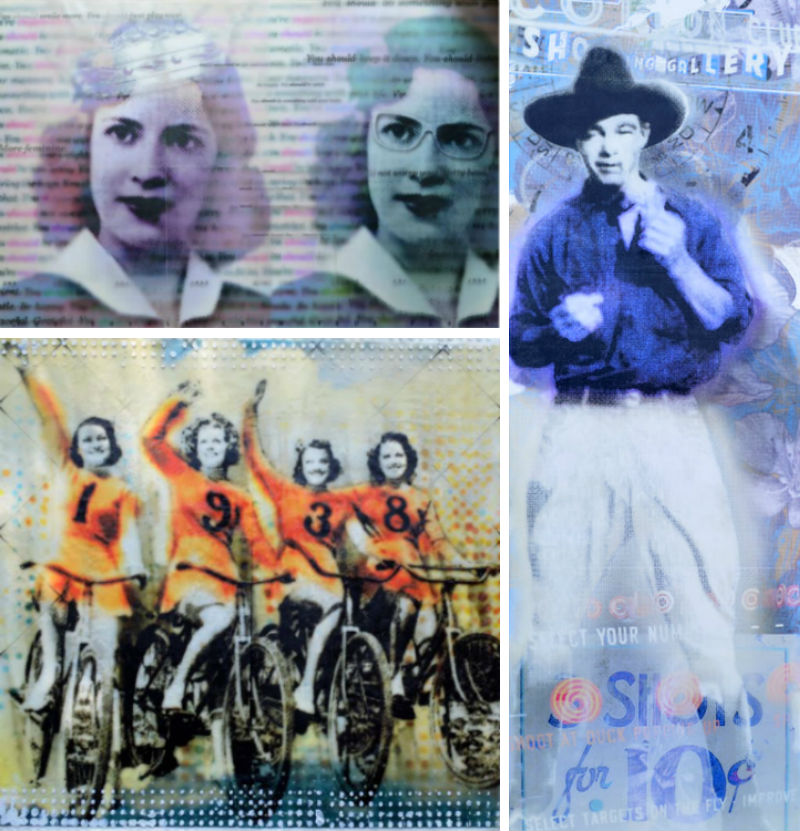Recombinant Tales: Ruth Crowe’s “Storytelling with Photo Infusion and Encaustic” at Gifts of Art

Taken separately, photo fusion and encaustic are interestingly differing forms of art. Taken together, they reflect local artist Ruth Crowe’s wry multimedia Storytelling with Photo Fusion and Encaustic exhibit at the Gifts of Art Gallery in the University of Michigan Hospital main corridor.
Crowe definitely has views she wants to communicate in her art, yet she’s not a polemicist. Rather, she allows for her work to speak for itself. It’s a brave strategy -- and it’s this subliminal perspective that speaks volumes of her views.
As Crowe says of her art in her online artist’s statement, “My work is a fusion of vintage photography that has been digitally altered and combined with layers of other images, photos, and sometimes words. I recreate a new story about the characters; my own story, from my own experiences.”
OK, but first a word about these photo fusion and encaustic paintings themselves. As mentioned above, Crowe’s work is a combination of two distinct kinds of artistry. And as her gallery statement tells us in a slightly different manner from her statement, she begins her work “with encaustics and image transfer processes ... combining personal and vintage photography with wax on wood.”
And what sounds accessible enough in words becomes gloriously riotous in practice. Crowe is playing on the notion that the very act of photography is only the first approximation of a uniquely value-laden aesthetic. And when Crowe fuses personal with public imagery -- say, for example, a personal photograph with a commercial image -- the result is commentary whose meaning can range from simple observation to pointed commentary.
This makes her meaning ambiguous as it’s often difficult to determine where Crowes’ personal viewpoint ends and her interpretation begins. And what this means in practice is that the public and the private sides of her art are a marvelous juncture where what Crowe does is illustrate the fault lines where her opinion resides.
On the other hand, Crowe’s use of encaustic pigments creates a curious distancing effect. Sometimes called “hot wax painting,” encaustic pigments give such paintings a subtle diaphanous veil that accents the composition. It’s not accidental that until relatively recently, this art form was often used in such a way where the sculpted surfaces lent the composition a gauzy, spiritual impression.
Because encaustic wax can be used as a pigment binder, these pigments can be sculpted as well as painted. Add the photographic or print materials that can be encased or collaged into the encaustic surface and these images create a faux three-dimensional surface tension that lies on the composition’s surface.
Put these pieces together and you would have Crowe’s 18-by-18-inch encaustic, image transfer, plaster Let’s Ride Sister -- Put the Fun Between Your Legs. where four collegiate-aged women sit astride their bicycle, three of them waving at the camera. They’re wearing old school gymnastic gear with each woman wearing a sweatshirt whose cumulative numbers add up to “1938.”
There’s no way of knowing to what degree Crowe has modified her composition, but the photo’s encaustic texture -- ranging from the recessive yellow, blue, and orange spotted background and foreground rows of mottled blue dots; supplemented by encaustic surface -- gives the composition a slightly out of focus diaphanous haze that could be commentary or recollection.
By contrast, Crowe’s 24-by-36 inch Notorious RBG is studied observation. This dual yearbook portrait -- demure with and without glasses -- is both solemn and salutatory. Justice Ginsberg’s photograph placed in front of rows of indistinct scripted commentary (with an occasional gender-based admonition) features one of our country’s most cherished heroines at the start of her career.
Of the 16 other photographic paintings in the exhibit, Another Kind of Cowboy is an especially spirited photo infusion and encaustic painting. Weighing in at 36-by-12 inches, this work is a surreal festival of differing visual metaphors: There are multitudinous, colorful arcade signs; a rootin’-tootin’ cowhand wearing a Tom Mix Stetson with his fists up; and a wild, swirling backdrop. It is indeed another kind of cowboy -- for another kind of art.
John Carlos Cantú has written on our community's visual arts in a number of different periodicals.
“Storytelling with Photo Fusion & Encaustic” is at the Gifts of Art Gallery – University Hospital Main Corridor, Floor 2, 1500 E. Medical Center Drive, Ann Arbor. On display through March 8. Open daily from 8 a.m.-8 p.m. For information, call 734-936-ARTS or visit med.umich.edu/goa.


































